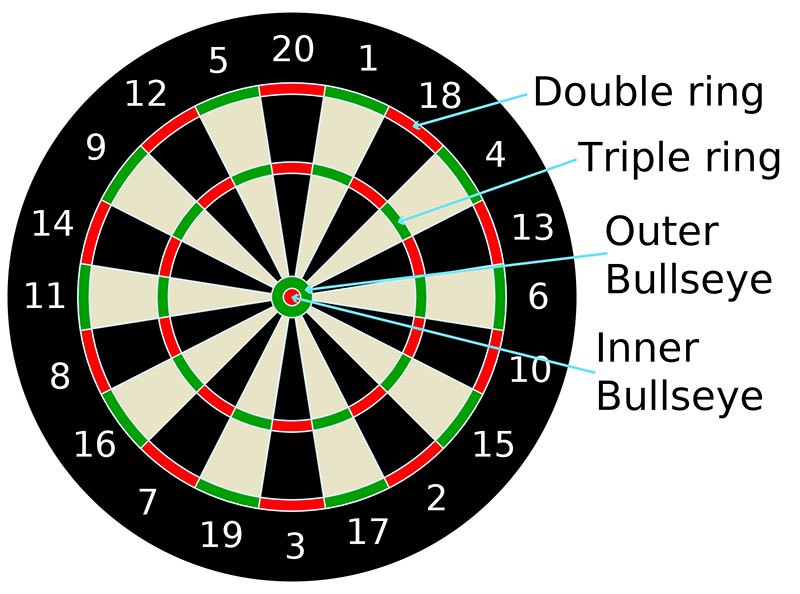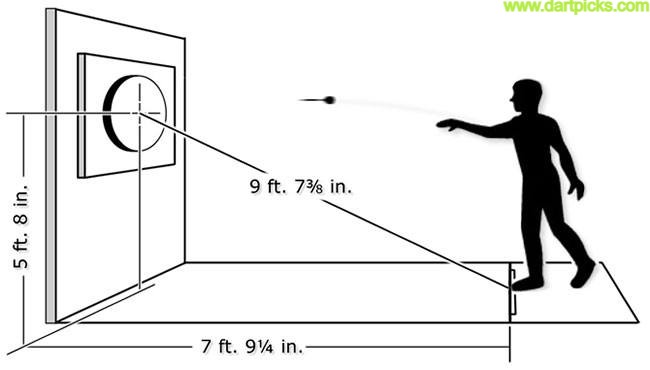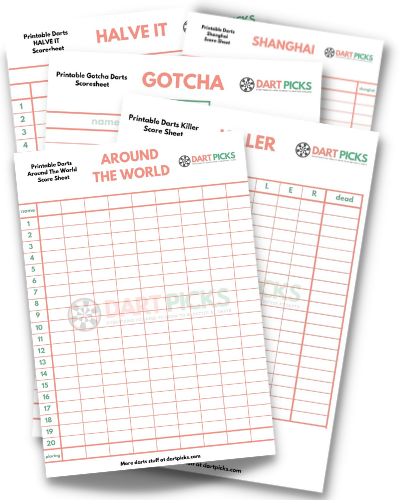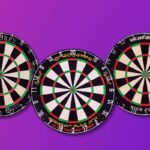Darts is a game that requires precision, dexterity, and skill. It’s also a lot of fun! This article will give you the basics for dart rules, how to play darts with your friends, and what you need to play at home. You’ll be playing in no time!
This article covers the traditional 501 version of darts however, there are many other games you can play with your darts and dartboard.
Check out our free 501 printable scoresheet.
Table of Contents
How to Play Darts: General Rules and Regulations
Darts, like every other game, has rules and regulations. Thankfully, there aren’t that many, so it’s really easy to learn and start playing.
The guidelines for a game of darts in a pub may be different from those in a competition. Nevertheless, no matter where the game of darts occurs, understanding the rules is fundamental to having a great game. Listed below, we cover the essential rules to playing darts you need to know.

Setting up your dartboard – the rules
1. Dartboard Key Features and Measurements
A regular dartboard, generally known as a “clock” board, is made up of 4 key parts, the DOUBLE RING, the TRIPLE RING, the OUTER BULLSEYE and the INNER BULLSEYE
- If you land a dart in the DOUBLE RING, you get twice the value stated on the edge of the board for that segment.
- If you land a dart in the TRIPLE RING, you get three times the value stated on the edge of the board for that segment.
- If you land a dart in the OUTER BULLSEYE, you get 25 points.
- If you land a dart in the INNER BULLSEYE, you get 50 points!

- An 18-inch diameter
- 20 pie-shaped, equal-sized calculated sections
- Each sector features a dual ring on the outer perimeter and a three-way ring on the internal area of the dartboard.
- A bull’s eye, which lies right in the dartboard facility, features an outer or single bull (25 points) and an inner or double bull’s eye (50 points).
Learn more about setting up a dartboard.
2. Dartboard Height
Whether you’re playing with the soft tip or steel idea darts, the elevation remains the same– exactly 5 feet 8 inches. It would help if you determined that from the facility of the bull’s eye.
You need to attach your dartboard to the wall. They usually come with the wall fixings that you need. It should be resting flush against the wall with the number 20 at the top.

3. Dartboard Distance
The distance from the dartboard itself to the toe line, or oche, needs to be measured to.
- The official horizontal distance between the board and the Oche (toe line) should be 7ft 9 1/4 inches or 297cm
- You can also measure the diagonal line from the facility of the bull’s eye to the toss line. It must be precisely 9 feet 7 3/8 inches.
The Basic Rules of 501 darts
Here the basic rules of 501 darts:
- Each player starts with a score of 501
- Players take it in turns to throw 3 darts at the dartboard
- Each player must throw from the toe line also known as the oche
- The aim of the game is to reduce your score to 0
- After a player has thrown 3 darts the total score is calculated and deducted from the starting score of 501
- The inner bullseye scores 50
- The outer bullseye scores 25
- Getting a dart in the triple ring means you multiply the value by 3
- Getting a dart in the double ring means you multiply the value by 2
- If the dart bounces off of the board or falls out, it doesn’t count
- If you have an established total of continuing to be factors, and you score above it, your toss will finish immediately and count as a no.
- If a player reduces their score to 1 or less than 0, they are bust and their score returns to the value it was before their current turn
Where to Stand?
Darts players stand and launch their darts from the toe line, commonly known as the oche.
The standard distance from the board to the oche is 7 feet 9¼ inches, but different distances can be used if you prefer, especially if playing with young children.

Other tips on how to improve your standing position:
- Your back foot must be behind the Oche, but only just.
- Your toes should also be pointing toward the board.
- Do not lean forward or bend over too far. This may cause you to lean over the Oche and will invalidate your turn.
- The dart must cross the oche completely for it to count as a valid throw.
- You should stand sideways on the board.
How to Throw a dart
Throwing a dart uses a pretty simple technique but can take lots of practice to master. Here are a few tips to help you get the perfect throw every time you play.
- Grip the dart in your hand, don’t hold it too tight or you might cause unnecessary pressure on your wrist muscles. This can sometimes lead to injury if done over a long period of time!
- Place the dart in between your thumb and index finger with the point facing upwards. If you’re left-handed, just use your left hand instead!
- We don’t recommend you use your ring finger and pinky to balance the dart in between throws, this will only restrict any movement you need to make. The goal is for your thumb and forefinger to be in control of the dart when you release it, without it moving much at all.
- If you’re right-handed, stand to the left of the board so your arm can extend straight forwards toward it. If you’re left-handed, the opposite applies.
- Finally, look at your target and focus your eyes on a specific point before you release the dart. This will help you hit your target score.
- Throw the dart directly forwards as if you were going to shoot an arrow from a bow. Similar to how archers aim further out depending on which direction their target is in comparison to them, we recommend aiming a little bit further out to the left when throwing right-handed and a little bit further in when throwing left-handed. This will help you get your accuracy up!
- The best way to practice is to take turns with friends or family at home; that way, everyone can enjoy themselves and improve their dart-throwing skills!
Here’s a video that takes you through the dart-throwing technique:
Final Thoughts
Now that you know a dartboard’s general rules and regulations, it’s time to set up your own. Get yourself a regulation-sized dartboard for the best results or find one at your local bar or pub! With regular practice, your friends will be impressed by how skilled you are in no time!
Alex Cooper is the editor of this website. He loves darts and helping people. Alex started playing darts at the young age of 10, as his father was also a keen darts player, and has loved it ever since. Alex enjoys writing about darts and helping others learn more about the sport.
The easy way to keep track of your score is with our printable darts scoresheets. Easy to download and keep on your phone or computer or print straight off from our website. Pop your email address into the box and we'll send them straight to you.






